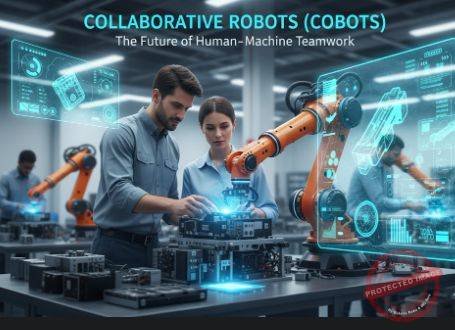How Intelligent, Safe, and Adaptive Robots Are Transforming Workplaces and Empowering Human Potential.
From Automation to Collaboration
For decades, robots worked behind fences—isolated on factory floors, programmed for precision but not partnership. Today, a new generation of robots is breaking down those barriers.
Enter collaborative robots, or cobots—machines designed to work with people, not replace them.
Cobots represent a fundamental shift in robotics: they blend the precision of automation with the adaptability of human intelligence. As industries evolve toward flexibility, speed, and personalization, cobots are becoming the cornerstone of Industry 5.0—the era of human–machine collaboration.
The Rise of Collaborative Robotics
Unlike traditional industrial robots, cobots are built for interaction, safety, and shared intelligence. They are equipped with sensors, vision systems, and AI-driven software that enable them to detect human presence, learn tasks quickly, and operate safely without physical barriers.
Key advantages driving cobot adoption:
-
Ease of integration: Lightweight, modular designs fit seamlessly into existing workflows.
-
Adaptability: Easily reprogrammed for different tasks or environments.
-
Safety: Force-limiting systems and AI perception minimize risk.
-
Accessibility: Lower costs make automation viable for small and mid-sized businesses.
According to the International Federation of Robotics, cobots now account for over 12% of all industrial robot installations worldwide—a number projected to double by 2030.
AI and the Intelligence of Collaboration
Artificial Intelligence has given cobots cognitive capability. They can recognize patterns, anticipate movements, and even learn from observation—bridging the gap between mechanical execution and contextual understanding.
-
Computer vision enables cobots to identify objects and human gestures.
-
Reinforcement learning refines task performance through trial and feedback.
-
Natural language processing (NLP) allows workers to instruct cobots via voice or gesture.
-
Predictive analytics optimize task scheduling and energy efficiency.
These advances turn cobots into adaptive teammates, capable of continuous learning and shared decision-making.
Cobots Across Industries
Collaborative robots are transforming a wide range of industries:
-
Manufacturing: Assembly, quality inspection, and packaging alongside human operators.
-
Logistics: Picking, palletizing, and warehouse sorting in dynamic environments.
-
Healthcare: Assisting surgeons or aiding patients in physical rehabilitation.
-
Agriculture: Harvesting crops and handling produce with gentle precision.
-
Retail and Service: Customer-facing robots offering support and product handling.
Each application demonstrates that the future of automation is not exclusion—it’s collaboration.
Human-Centric Design and Safety
The hallmark of cobots is safety. Advanced proximity sensors, torque monitoring, and AI-based motion prediction ensure humans and robots can work side by side confidently.
International safety standards like ISO 10218 and ISO/TS 15066 define performance criteria for collaborative operation, ensuring cobots:
-
React instantly to touch or proximity.
-
Operate at controlled speeds when near people.
-
Resume normal function when humans move away.
This design philosophy embodies a larger trend—technology built around humans, not the other way around.
Workforce Empowerment and Reskilling
Cobots aren’t replacing workers—they’re redefining work. By automating repetitive, ergonomically challenging, or hazardous tasks, they allow employees to focus on creative, analytical, and supervisory roles.
Manufacturers and educators are investing in cobot training programs to upskill workers in robot programming, maintenance, and data analysis.
In this model, humans become orchestrators of automation, guiding intelligent systems toward greater efficiency and innovation.
Small Business, Big Opportunity
Cobots are leveling the playing field for small and medium enterprises (SMEs). Unlike large industrial robots, cobots are cost-effective, space-efficient, and easy to deploy.
For small manufacturers, cobots provide:
-
Rapid ROI through productivity gains.
-
24/7 operation without major infrastructure changes.
-
Enhanced quality control and consistency.
This democratization of automation ensures that digital transformation is accessible to all, not just global giants.
Closing Thoughts and Looking Forward
Collaborative robots represent a profound evolution in the relationship between humans and machines. They embody the spirit of Industry 5.0—where innovation serves humanity, not replaces it.
As AI advances and safety systems evolve, cobots will become ubiquitous partners in factories, labs, offices, and even homes.
The future of robotics isn’t about isolation or automation—it’s about collaboration. And in that shared space between man and machine, the next revolution in productivity and creativity is already unfolding.
References
-
“Collaborative Robotics and the Future of Work” – World Economic Forum
https://www.weforum.org/agenda/2024/08/collaborative-robotics-and-the-future-of-work -
“Cobots in Industry 5.0: Redefining Human–Machine Partnerships” – McKinsey & Company
https://www.mckinsey.com/industries/advanced-electronics/our-insights/cobots-in-industry-5-0 -
“Safety Standards and Human–Robot Collaboration” – Deloitte Insights
https://www.deloitte.com/insights/safety-and-human-robot-collaboration -
“AI and Adaptive Learning in Collaborative Robotics” – MIT Technology Review
https://www.technologyreview.com/2024/09/22/ai-and-adaptive-learning-in-collaborative-robotics -
“Cobots and the Democratization of Automation” – Forbes Tech Council
https://www.forbes.com/sites/forbestechcouncil/2024/10/05/cobots-and-the-democratization-of-automation
Author: Serge Boudreaux – AI Hardware Technologies, Montreal, Quebec
Co-Editor: Peter Jonathan Wilcheck – Miami, Florida
#Cobots #Robotics #AI #Automation #Industry50 #DigitalTransformation #Manufacturing #Collaboration #Innovation #TechNews
Post Disclaimer
The information provided in our posts or blogs are for educational and informative purposes only. We do not guarantee the accuracy, completeness or suitability of the information. We do not provide financial or investment advice. Readers should always seek professional advice before making any financial or investment decisions based on the information provided in our content. We will not be held responsible for any losses, damages or consequences that may arise from relying on the information provided in our content.



